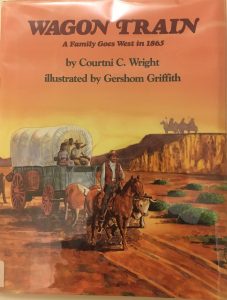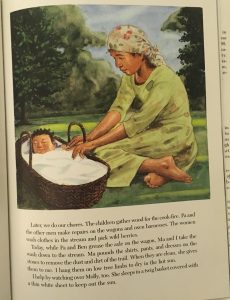Title: Wagon Train: A Family Goes West in 1865
Author(s): Courtni C. Wrights
Illustrator/Photographer: Gershom Griffith
Publisher and Year: Holiday House; 1995
Number of Pages: 30
Tags: Adventure, Culture, Family, Historical Fiction, Picture Book, 2-3, 4-5, Sarah Luce
Genre: Historical Fiction
Descriptive Annotation:
Wagon Train is about an African American family that travels west in a wagon train after being freed from slavery. Along the way, they encounter dangerous animals, brutal weather, and Native Americans. The story ends with the hope that the family will safely make it to California. There is an Author’s Note on the first page talking about the treatment of African Americans and how they too travelled west, despite the lack of records of their experiences. Students would find it helpful to know about the Oregon Trail and the Westward Expansion.
Classroom Application:
This text would be perfect for reinforcing material taught about the Oregon Trail and Westward Expansion. It could be used in the middle of a unit to give students a window into the hardships and experiences these settlers faced. It is also a good text to use to reinforce that not just White people went west, but so did many African Americans after the Civil War.
Linguistic and Cultural Diversity Analysis:
Wagon Train not only represents the culture of westward settlers and those living in covered wagons as they travelled, but also the culture of African Americans who set out on the same journey. These people had an even worse expedition, because they could not “join one of the big trains leaving Independence, Missouri” (page 8). Being in a smaller train meant less support from others and more danger. Because “few could write diaries to record their experiences,” this book is important in showing students what the journey west was potentially like for African Americans (page 1). If I used this story in the middle of an Oregon Trail unit, I would introduce it as a story about a group of people who were not well documented, but were an important part of the movement nonetheless.
Illustration:


